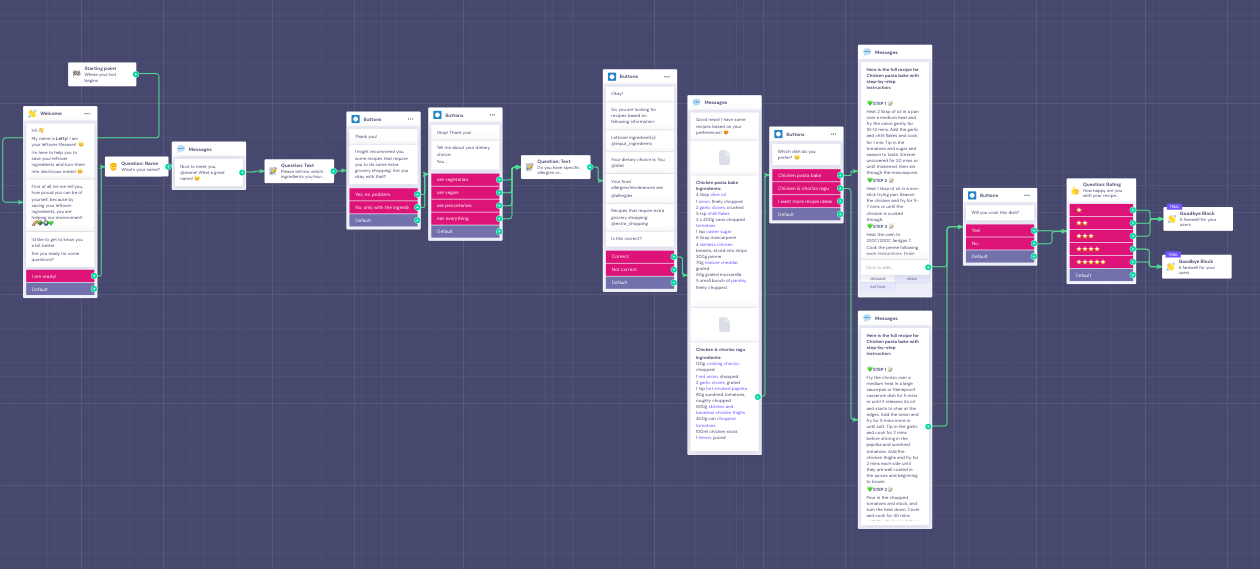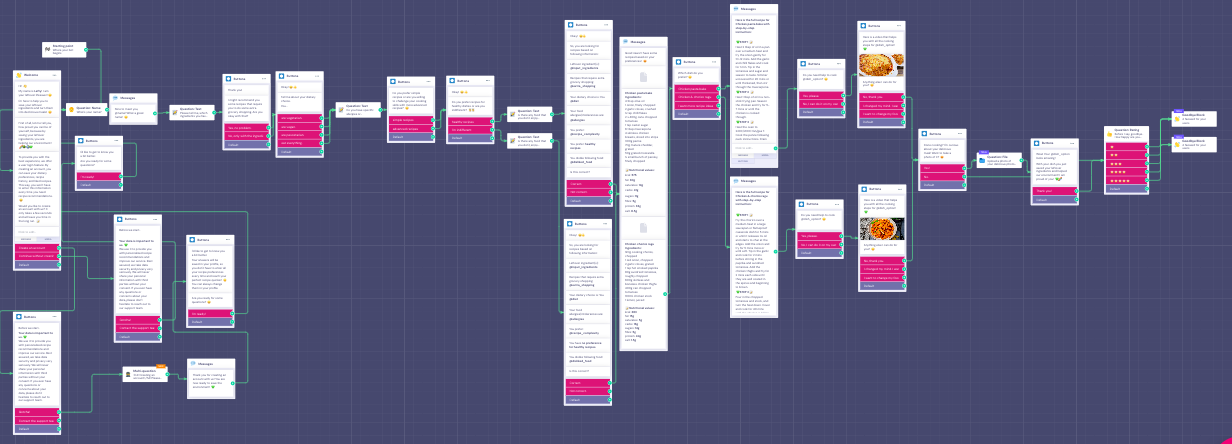PREMISE
Using chatbot technology to assist students in using their leftover ingredients efficiently by suggesting personalized recipes.
SYNOPSIS
The production of food is one of the major drivers of global greenhouse gas emissions. Greenhouse gases are the reason for a multitude of environmental and health consequences. The environmental impact of food production and consumption is further exacerbated when food is wasted rather than consumed. As a result, the reduction of food waste has become a primary objective of global and national political agendas. The biggest amount of food waste worldwide is produced by private households. Young adults aged 18-34, particularly students waste a higher proportion of food than other age groups. One of the main reasons for wasting food is their incapability to consume leftover ingredients, which stems from their lack of cooking experience and meal ideas. Hence, this project aims to discover how chatbot technology can tackle this problem by suggesting students personalized recipes.
SUBSTANTIATION
Food waste among students
In 2019, approximately 931 million tons of food waste were generated, with 61% of it originating from households (UNEP Food Waste Index Report, 2021). Studies conducted by Bravi et al. (2020b) and Ellison et al. (2019) have shown that young adults aged 18-34 waste a higher proportion of food than other age groups, with students being a significant audience in this age group. According to Mondéjar-Jiménez et al. (2016), the group of students wastes over 6% of the food they purchase each week. Research has also found out that even though students being one of the largest sources of avoidable food waste, they are more likely to engage in food waste reduction behaviors (Attiq et al., 2021). Therefore, they have the most significant potential to decrease their personal food waste and make a positive impact on overall waste reduction. According to Farr-Wharton et al. (2014) and Ozeanne et al. (2022), one of the primary causes of food waste caused by students is their incapability to consume leftover ingredients. Students’ inability to utilize their leftover items creatively stems from their lack of cooking experience and food management skills. Their lack of cooking experience results in lacking meal ideas, ultimately leading them to purchase new groceries instead of repurposing existing items at home (Ozeanne et al., 2022). Assisting students with finding recipes based on their leftover ingredients and personal dietary preferences illustrates an approach to tackle this problem. A study on consumer views on food waste campaigns by Kim et al. (2019) revealed that offering online recipes was viewed as useful in resolving the issue of lack of cooking experience, which is one of the key barriers to leftover reuse. Even though, due to the evolution of the internet, students have access to a vast array of recipes and cooking resources online (Aspray et al., 2013), the high amount of information can be overwhelming for them. According to Noskova et al. (2021) in the open, accessible and frequently updated digital environment, the ability to quickly and conveniently extract the necessary and relevant knowledge becomes a priority for students. Additionally, changing food consumer behaviors and preferences driven by factors such as health (e.g. allergies) and dietary lifestyles (e.g. vegetarianism and veganism) make the search for personalized food recipes even more complex and less convenient (Volpentesta et al., 2017).
The combination of being able to gather conveniently quick and personalized information of new technologies, such as a chatbot (Brandtzaeg & Følstad, 2017), might be the potential solution to help students find recipes based on their personal preferences and ultimately reduce their food waste.
PROJECT
The project benefited from the chatbot workshop. I decided to develop my chatbot (Lefty, the Leftover Lifesaver) with Landbot. Before building the chatbot, a survey was conducted to gather information on the needs and challenges of students not being able to use their leftover ingredients and to identify desired features for the chatbot. The survey was shared through a link to students with different backgrounds in order to gain an all-round understanding of this matter.
SOME IMPORTANT SURVEY INSIGHTS






PROTOTYPING
ITERATION 1
The first iteration of the chatbot design includes a welcome message and questions in order to make the perfect recipe recommendations. The welcome message includes a short introduction of the chatbot and its purpose and a motivational message stating that with using the chatbot and trying to find a way to use leftover ingredients, instead of throwing them away, the student is doing our environment good.
The questions include students’ leftover ingredients, dietary preferences and allergies/intolerances and whether the students want recipe recommendations that require some extra grocery shopping or not. At the end of the process, the user has the option to rate the chatbot and share the chatbot on socials with others.

USER TESTING
The user testing was conducted with 5 students at Hogeschool Utrecht. Before starting the user testing, task scenarios were formulated to ask participants to take actions on the tested chatbot. After the testing sessions, the students were asked some questions, leading to the identification of several areas of improvement. Participants found the navigation of the chatbot easy and user-friendly and liked the social purpose of the technology. However, some students suggested that the chatbot should consider the complexity of a recipe, as well. The reason behind this suggestion was, that some students might prefer more simple recipes due to their lack of cooking skills or lack of available time to prepare a more complex meal. Furthermore, students suggested being asked if they prefer for healthy recipes and they would like to see the nutritional values of each recipe, as well. Last suggestion was, including cooking videos of the dishes if the student needs extra assistance.
ITERATION 2
In the second iteration of the chatbot design, several improvements and features were added based on the insights of the first user testing. The features include a question about the complexity of a recipe, the preference for healthy recipes and the illustration of the nutritional values of each recipe. Furthermore, cooking videos of the recommended recipes were incorporated, in case of student needing extra assistance with cooking.

USER TESTING
The second user testing took place with another 5 students at Hogeschool Utrecht to gather insights for further improvements for the third iteration. The participants found the chatbot’s prompts and questions easy to understand and appreciated the personalized recipe recommendations. The option of watching cooking videos was perceived as highly valuable, since according to the participants, some students might struggle following the recipe without having any visual guidance. Following points of improvement were mentioned: talking about data usage and security, being able to create a profile and saving recipe preferences and other personal information (voted recipes, recipe history, etc.) on that profile for future and more convenient interactions with the chatbot. Asking for disliked food to exclude them in the recipe recommendation was suggested, as well. Furthermore, students suggested being able to upload the self-made dish in order to make the experience more interactive and have a proof they really cooked the dish and did something good for the environment.
ITERATION 3
The final iteration includes all the valuable insights gathered from the second user testing. The chatbot has been further improved and enhanced with several new features to provide an even more personalized and convenient experience to the users. The chatbot now allows the users to create a profile and save their recipe preferences and personal information, making it easier for them to interact with the chatbot in the future. The chatbot now also considers the users’ disliked foods to exclude them from recipe recommendations and an interactive feature that on one hand, allows users to upload their self-made dish, providing them with a sense of achievement and contributing to a more engaging experience and on the other hand serves as a tool that shows whether students really used their leftover ingredients or not. The chatbot also ensures data security and privacy by informing users about data usage policies. Overall, iteration 3 represents the best version of the chatbot, which has been designed with the user’s convenience, satisfaction, and privacy in mind.

CONCLUSION
The project aimed to reduce food waste among students, that struggle knowing what to do with their leftover ingredients. The chatbot was developed to recommend personalized recipes to students in order to tackle the problem of food waste. The chatbot’s design aimed to collect essential information about the user’s leftover ingredients, dietary preferences, allergies and intolerances, etc. With the findings from the survey and the testing sessions, the final iteration got created. All in all, students liked the idea of getting assistance in finding the right recipe based on their leftover ingredients and personal wants and needs regarding food. Students found the navigation and interaction with the chatbot user friendly, convenient and very personal. The features along the whole journey were perceived as very useful.
However, in order to improve the recommendation system, further research could be conducted, to explore the variations in taste preferences among students from diverse cultural backgrounds. In addition, further investigation in how to make the chatbot more engaging and interactive with cooking challenges and games and incorporating more human-like conversation with natural language processing capabilities could contribute to its more success. More research could focus on finding better ways to measure the chatbot’s efficiency to know if the students really used their leftover ingredients to create the recommended dish.
REFERENCES
Aspray, W., Royer, G., & Ocepek, M. G. (2013). Food in the Internet Age. In Springer eBooks. Springer Nature. https://doi.org/10.1007/978-3-319-01598-9
Attiq, S., Habib, M. A., Kaur, P., Hasni, M. J. S., & Dhir, A. (2021). Drivers of food waste reduction behaviour in the household context. Food Quality and Preference, 94, 104300. https://doi.org/10.1016/j.foodqual.2021.104300
Bravi, L., Francioni, B., Murmura, F., & Savelli, E. (2020b). Factors affecting household food waste among young consumers and actions to prevent it. A comparison among UK, Spain and Italy. Resources Conservation and Recycling, 153, 104586. https://doi.org/10.1016/j.resconrec.2019.104586
Brandtzaeg, P., & Følstad, A. (2017). Why People Use Chatbots. Springer EBooks, 377–392. https://doi.org/10.1007/978-3-319-70284-1_30
Ellison, B., Savchenko, O. M., Nikolaus, C. J., & Duff, B. R. L. (2019d). Every plate counts: Evaluation of a food waste reduction campaign in a university dining hall. Resources Conservation and Recycling, 144, 276–284. https://doi.org/10.1016/j.resconrec.2019.01.046
Farr-Wharton, G., Foth, M., & Choi, J. H. (2014). Identifying factors that promote consumer behaviours causing expired domestic food waste. Journal of Consumer Behaviour, 13(6), 393–402. https://doi.org/10.1002/cb.1488
Kim, J., Rundle-Thiele, S., Knox, K., Burke, K., & Bogomolova, S. (2020). Consumer perspectives on household food waste reduction campaigns. Journal of Cleaner Production, 243, 118608. https://doi.org/10.1016/j.jclepro.2019.118608
Mondejar-Jimenez, J., Ferrari, G., Secondi, L., & Principato, L. (2016). From the table to waste: An exploratory study on behaviour towards food waste of Spanish and Italian youths. Journal of Cleaner Production, 138, 8–18. https://doi.org/10.1016/j.jclepro.2016.06.018
Noskova, T., Pavlova, T. V., & Yakovleva, O. (2021). A Study of Students’ Preferences in The Information Resources of The Digital Learning Environment. Journal on Efficiency and Responsibility in Education and Science, 14(1), 53–65. https://doi.org/10.7160/eriesj.2021.140105
Ozanne, L. K., Ballantine, P. W., & McMaster, A. L. (2022b). Understanding Food Waste Produced by University Students: A Social Practice Approach. Sustainability, 14(17), 10653. https://doi.org/10.3390/su141710653
UNEP Food Waste Index Report 2021. (n.d.). UNEP – UN Environment Programme. https://www.unep.org/resources/report/unep-food-waste-index-report-2021
Volpentesta, A. P., Felicetti, A. M., & Ammirato, S. (2017). Intelligent Food Information Provision to Consumers in an Internet of Food Era. IFIP Advances in Information and Communication Technology, 725–736. https://doi.org/10.1007/978-3-319-65151-4_65